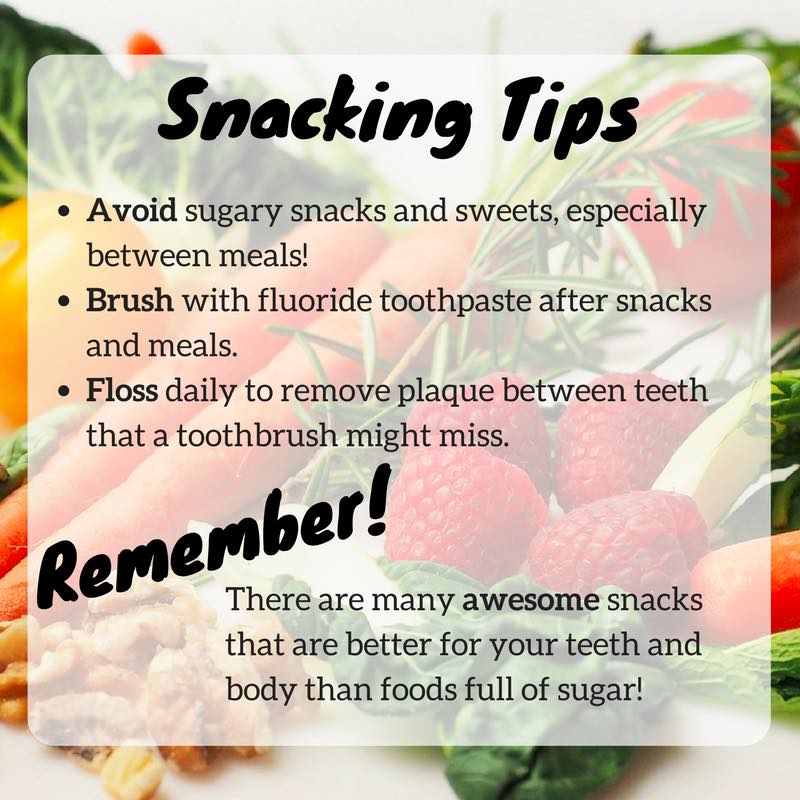Take Control Of Your Family’s Health!
Helping your kids to eat healthily can be tough, but it’s worth it. Luckily, there are plenty of nutritious snacks that taste great, too!
In today’s post, we’ll share our tips for helping your kids (and yourself!) to choose healthy, nutritious snacks and treats. We’ll also discuss how the germs in your mouth cause cavities in your teeth and how your whole family should be snacking.
Why Does Healthy Eating Matter?
One of the best ways to get older kids excited about eating healthy is to explain why healthy eating is so important for their teeth and bodies. It can even be extra-helpful to ask your dentist or family physician for help! We’re always happy to explain the importance of dental health and how it impacts your whole-body health.
At Children’s Dentistry of Charlottesville, our dentists can explain how bacteria use sugars to harm teeth. Understanding the process can be instrumental in changing the way your family thinks about snacking.
 Where Do Those Bacteria Come From?
Where Do Those Bacteria Come From?
Everyone has millions of bacteria in their mouth. These bacteria aren’t harmful but can form a sticky material on the surface of the teeth called plaque— which can contribute to cavities, tooth decay, and other dental health problems.
When you eat sweets (or drink sugary beverages), the plaque converts that sugar into acids that dissolve the outer layer of the tooth, called enamel. When the enamel structure is dissolved it is considered demineralized.
A cavity forms when the enamel is affected to the extent that remineralization is no longer possible. The more you eat and snack, the more frequently you are exposing your teeth to the cycle of decay.
Certain sweets can cause more damage than others. Chewy and sticky sweets stay in the mouth longer and give the tooth a longer sugar bath.
The more frequently you take in sugar, the more often you feed the bacteria. Meaning they’re producing more enamel-dissolving acids.
TIP: If you choose to eat sweets, it is better to save it for dessert after a meal rather than snacking throughout the day. It’s also important to note that lemonade, all sodas, and energy drinks are already highly acidic and contribute to enamel damage on their own!
Acidic foods lead to demineralization. Foods like citrus fruits, tomatoes, and lemons should be eaten as part of a larger meal to minimize the effect of acids they contain.
Cookies, candy, cakes pies, chips, fries, raisins and dried fruits contain large amounts of sugar and can stick to teeth. This provides a fuel source for bacteria.
If you choose to eat these foods, make sure you brush your teeth immediately after.
Caring For Your Teeth & Minimizing Cavities
Fluoride Treatments
Fluoride in over-the-counter toothpaste help remineralize dissolved teeth. Additionally, professionally applied fluoride during routine dental visits contain higher concentrations of fluoride. This will help make teeth stronger!
Once a cavity starts in a tooth, it can’t be remineralized.
 Don’t Drink Too Much Juice!
Don’t Drink Too Much Juice!
The American Association of Pediatric Dentists (AAPD) recommends no more than 4-6 ounces of fruit juice per day.
For infants, nighttime bottle-feeding with juice, repeated use of sippy cups, and frequent in-between meal consumption of sugar-containing snacks or drinks (juice, formula, soda) increase the risk of caries (cavities).
Infants should only have water before bed. Their teeth should be brushed before going to bed, too. Along with increasing caries risk, increased consumption of sugar-sweetened beverages and snack foods also has been linked to obesity.
 Benefits of Breastfeeding
Benefits of Breastfeeding
The AAPD encourages breastfeeding infants to ensure the best possible health and developmental psychological outcomes. Make sure to start wiping or brushing as the first primary tooth begins to erupt and other dietary carbohydrates are introduced.
Breast milk is very important for growth and development but can cause cavities if left on teeth overnight. Make sure you brush or wipe the teeth off with a damp washcloth immediately after.
Remember it’s very important to only give your child water when going to bed.
Great Snack Ideas For Kids

Best Beverage Choices:
- Water
- Milk
- Unsweetened tea
Best Foods For Oral & Dental Health:
- Cheese
- Broccoli
- Spinach
- Meat
- Nuts
- Milk
These foods protect tooth enamel by providing the calcium and phosphorus needed to remineralize teeth. Remineralization is a process by which minerals are deposited in tooth enamel after being removed by acids.
Other Good Food Choices:
- Apples
- Pears
- Veggies
While these foods do contain sugar, these sugars are diluted by the high water content in them.
Healthy Foods Are Fun AND Delicious!
Encourage your kids that healthy foods can also be fun and delicious!
Get Creative With Fun, Healthy Snack Combos
Try combinations of foods that look and taste good, like:
- Fruit slices with peanut butter
- Fruit smoothies
- Meat and cheese roll-ups
 Make Grocery Lists Together
Make Grocery Lists Together
Ask your kids what kind of foods they like to eat and help them understand what’s healthy for them and what’s not.
Then go grocery shopping together and teach them how to read Nutrition Facts labels so they can check the sugar content.
 Avoid Added Sugars!
Avoid Added Sugars!
Choose foods that do not contain added sugars.
These added sugars should be avoided and include:
- Corn syrup/sweetener
- Maltose
- Fructose
- Sucrose
- Glucose
- Dextrin
- Fruit juice concentrate
- Honey
- Evaporated cane juice
- Malt syrup
- Maple syrup
- Molasses
- Anything with the word “sugar”!
TIP: Try making a game of it and see how many great snacks you can find without added sugar. You’ll be surprised how tricky it can be– but your teeth and your body will thank you!
 Preparing Meals
Preparing Meals
When preparing meals, make sure fruits and veggies are always on the plate to get them used to eating healthy.
Every now and then, it is okay to enjoy an ice cream cone or slice of cake, but make sure the bulk of the foods they eat are nutritious.
 Don’t Forget to Brush!
Don’t Forget to Brush!
It is important to brush after every meal!
The bottom line: teach your kids that eating healthy can be fun. You can enjoy your sweets once in a while, but brush after!
Our Top Snacking Tips:

More Of Our Favorite Healthy Snacks!
Fresh Fruits and Raw Vegetables:
- Unsweetened fruit and vegetable juices
- Canned fruit in natural juice
- Oranges
- Melons
- Pineapple
- Pears
- Broccoli
- Celery
- Carrots
- Tomatoes
- Grapefruit
- Celery
Milk And Dairy Products:
- Low or non-fat cottage cheese
- Low or non-fat milk
- Low or non-fat yogurt
- Low or non-fat cheese
Meats & Nuts:
- Chicken
- Turkey
- Pumpkin seeds
- Nuts
- Sunflower seeds
- Peanut butter (unsalted or low-salt)
*Correction: a previous version of this post stated: A cavity forms when the next layer of tooth, the dentin, becomes involved. This has been updated to reflect that a cavitation of the enamel can occur.

A graduate of Loma Linda University Dental School and a resident in the Loma Linda Dental Anesthesiology Program, Dr. Will received extensive education in pharmacology, physiology, internal medicine, and general anesthesia. Dr. Will is a member of the Special Care Dentistry Association and the American Society of Dentist Anesthesiologists. He’s also a Diplomate of the American Dental Board of Anesthesiology. Dr. Will believes every patient should be treated with kindness and respect and is focused on treating the unique dental and oral health needs of all young people.



 Where Do Those Bacteria Come From?
Where Do Those Bacteria Come From? Don’t Drink Too Much Juice!
Don’t Drink Too Much Juice! Benefits of Breastfeeding
Benefits of Breastfeeding Make Grocery Lists Together
Make Grocery Lists Together Avoid Added Sugars!
Avoid Added Sugars! Preparing Meals
Preparing Meals Don’t Forget to Brush!
Don’t Forget to Brush!